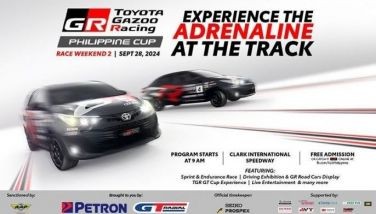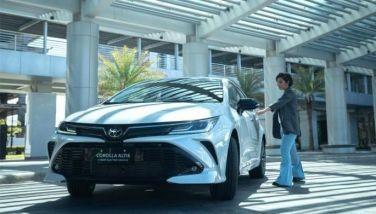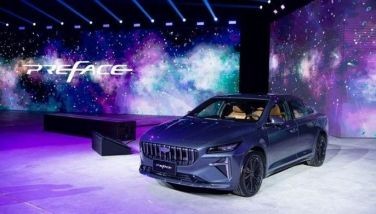Diesel Power
June 21, 2006 | 12:00am
In the old days, we used to look upon diesel as the working man’s fuel. With the exception of the "status SUVs" like the Mitsubishi Pajero and Isuzu Trooper and a few diesel Mercs, unless you drove a pickup truck or an AUV for a living, you’d have to be just a little bit quirky to actually want a diesel-powered car. I remember the 80’s-era Isuzu Gemini as the staple of taxi fleets. In the early 90’s, Nissan offered a diesel version of the box-type Sentra. I don’t remember if it was meant for taxi fleets or private owners, but I do know that the gasoline-powered Sentras, Toyota Corollas, and Mitsubishi Lancers of its day were far, far more popular.
Now that fuel price hikes are becoming more frequent than coup rumors, I wonder if more and more motorists aren’t ruing the day they decided to get a gasoline-powered vehicle. Urban-based motorists perennially stuck in traffic, and running on 4-cylinder engines, get anywhere from 6 to 8 kilometers per liter. Add 2 or 4 more cylinders and the number can dip to below 5kpl. Some especially economical cars like the Kia Picanto, Honda Jazz, and Toyota Vios might do better than 8 on average (I’m not talking of controlled driving conditions here like what the Department of Energy does). Diesel drivers, on the other hand, get upwards of 8 to 14kpl despite the worst that Manila can throw at them.
There’s a fairly complex explanation for why diesel tends to be more fuel-efficient than gasoline in traffic, but the layman’s version is that the high compression characteristics of a diesel engine translates to more torque at a lower rpm. And in traffic, or in most real-world driving situations for that matter, the low end of the engine range is used most often. Say, 2,000 to 3,000 rpm. Coincidentally, this is where most diesel engines are happiest. Look at the performance profile of any diesel and you’ll see a plateau-like torque curve in this region. As engine speed goes up, the performance gains taper off. Usually, the high-compression nature of a diesel precludes it from revving beyond 5,000 rpm (4,500 is usually the redline); otherwise, it might grenade itself. But at the low end of the engine range, in which you’re barely stepping on the accelerator, diesels give more power vis-à-vis a gasoline type, hence, therefore and ipso facto there’s less fuel consumption for the former than with the latter.
If practicality were the sole reason for engine selection, diesel would be the obvious choice. But real-world drivers also happen to like the other facets of an internal combustion engine, such as ample horsepower, "nice noises", cleaner emissions, and a pleasing absence of vibration. A normally aspirated, 2.5-liter diesel (such as an Isuzu Crosswind’s) churns almost the same as a 1.3-liter Honda Jazz. The torque-rich Crosswind might have a more urgent step-off from a standing start, but the Jazz will be up and away within 100 feet. Plus, real-world drivers aren’t always stuck in traffic; they use the highways too.
On long and fast stretches of road, horsepower translates to high, yet relaxed cruising speeds, which is why most cars zip past pickups, SUVs, vans, and AUVs that are already straining to keep things moving at 120kph. And while they’re savoring refined, humming noises from their motors, most diesel owners have nothing but a clattering racket emanating from beyond the firewall; about as appealing as a Con-Ass debate, only a little more entertaining.
Lately though, developments in diesel technology suggest that it might be the Next Big Thing in internal combustion. With spark ignition (gas) engines, it was overhead camshafts and variable valve timing (and even variable displacement) hitting the mainstream. With compression ignition (diesel), it is now injection technology; a combination of hardware and computer algorithms, making fuel delivery so much more efficient that you get more power out of a given "spritz" of a fuel-air mixture.
Around 6 years ago, Isuzu introduced common-rail injection with the Trooper. Compared with the old direct-injection diesel, it revved almost like a spark ignition engine, produced more power and torque, and gave out fewer emissions to boot. The midsize Alterra uses an even more advanced injector system and performs even more smoothly. Same thing with Toyota’s IMV products: the common rail-injected Fortuner, Hilux, and Innova. For the Commercial Vehicle market, which basically encompasses vans, pickups, SUVs, and AUVs, I think common rail technology will become the norm in a few more years, at least for the high-end variants bought for private use if manufacturers want to stay competitive.
The passenger car market, on the other hand, is solidly fixated on spark ignition engines, similar to the American preference for gasoline instead of the more pragmatic European approach which relies heavily on diesel for most of its cars due to the prohibitive cost of fuel. Is this a reason to blame "colonial mentality" once again? A lack of economies of scale? Manufacturing inertia? A stigma on diesel being noisy, stinky, and un-sexy?
Two weeks ago, I had a 2-liter Ford Focus Sport for a weekend. It’s a very competent and good-looking car, with a very stable and well-sorted out chassis, but every time I peeked at the in-car computer’s estimated fuel economy "15l per 100km", or an uncomfortable 6.67kpl, I couldn’t help but wonder just how much worse (or better) a diesel option might be. The 2-liter Duratorq diesel Focus available in Europe produces 136 horsepower and 34 kg-m of torque, for example.
Perhaps due to the more flexible nature of their businesses, which imports cars rather than having to manufacture them here by the thousands, the high-end Europeans are actually more imaginative with their product lines. BMW Philippines has quite an extensive lineup, offering diesel powertrains for the 7- and 5-Series sedans and the X5 and X3 Sports Activity Vehicles. Audi (through PGA Cars) similarly offers diesel versions of the A4 and A6 sedan and the new Q7 SUV.
None of these are laggards either. The BMW 530d actually has more torque than a Ford Expedition and almost as much power, while the A4 Avant I drove a couple of weeks ago was quite happy both in stop-and-go traffic and in high-speed cruising. Apart from muffled grumbling noises at idle, the latest diesels sound quite civilized too. They still don’t fire up the blood at high rpm like a well-tuned spark ignition engine does, but how many of us these days want to rev an engine and waste gas anyway? As for emissions, the latest engines conform to stringent Euro-4 standards, which makes them cleaner than the average, gas-burning engine here.
And if there are still any doubts that diesel has no place in enthusiasts’ hearts, Audi will be quite happily show you results from the 2006 Le Mans 24 Hours, in which their R10 TDI cars handily won 1st and 3rd place, setting a new milestone in Le Mans history while also consuming the least amount of fuel.
Of course, this is all very nice if you have the money to spare for a multimillion peso luxury car, but if you’re solidly in the mainstream looking for a diesel-powered car, you’re simply out of luck. Even though diesel isn’t immune to fuel price hikes, it will always be cheaper than gas because of the lower cost of producing it from crude oil. While affordable alternative-fuel vehicles are still a long way off in the horizon, and given the (still) largely untapped potential of diesel both as an engineering challenge and as a marketing opportunity, I wonder when a major car manufacturer will try to make inroads in the market with a state-of-the-art diesel powertrain soon.
Speak out, be heard and keep those text messages coming in. To say your piece and become a "Backseat Driver", text PHILSTAR<space>FB<space>MOTORING<space>YOUR MESSAGE and send to 2840 if you’re a Globe or Touch Mobile subscriber or 334 if you’re a Smart or Talk ’n Text subscriber or 2840 if you’re a Sun Cellular subscriber. Please keep your messages down to a manageable 160 characters. You may send a series of comments using the same parameters.
Now that fuel price hikes are becoming more frequent than coup rumors, I wonder if more and more motorists aren’t ruing the day they decided to get a gasoline-powered vehicle. Urban-based motorists perennially stuck in traffic, and running on 4-cylinder engines, get anywhere from 6 to 8 kilometers per liter. Add 2 or 4 more cylinders and the number can dip to below 5kpl. Some especially economical cars like the Kia Picanto, Honda Jazz, and Toyota Vios might do better than 8 on average (I’m not talking of controlled driving conditions here like what the Department of Energy does). Diesel drivers, on the other hand, get upwards of 8 to 14kpl despite the worst that Manila can throw at them.
There’s a fairly complex explanation for why diesel tends to be more fuel-efficient than gasoline in traffic, but the layman’s version is that the high compression characteristics of a diesel engine translates to more torque at a lower rpm. And in traffic, or in most real-world driving situations for that matter, the low end of the engine range is used most often. Say, 2,000 to 3,000 rpm. Coincidentally, this is where most diesel engines are happiest. Look at the performance profile of any diesel and you’ll see a plateau-like torque curve in this region. As engine speed goes up, the performance gains taper off. Usually, the high-compression nature of a diesel precludes it from revving beyond 5,000 rpm (4,500 is usually the redline); otherwise, it might grenade itself. But at the low end of the engine range, in which you’re barely stepping on the accelerator, diesels give more power vis-à-vis a gasoline type, hence, therefore and ipso facto there’s less fuel consumption for the former than with the latter.
If practicality were the sole reason for engine selection, diesel would be the obvious choice. But real-world drivers also happen to like the other facets of an internal combustion engine, such as ample horsepower, "nice noises", cleaner emissions, and a pleasing absence of vibration. A normally aspirated, 2.5-liter diesel (such as an Isuzu Crosswind’s) churns almost the same as a 1.3-liter Honda Jazz. The torque-rich Crosswind might have a more urgent step-off from a standing start, but the Jazz will be up and away within 100 feet. Plus, real-world drivers aren’t always stuck in traffic; they use the highways too.
On long and fast stretches of road, horsepower translates to high, yet relaxed cruising speeds, which is why most cars zip past pickups, SUVs, vans, and AUVs that are already straining to keep things moving at 120kph. And while they’re savoring refined, humming noises from their motors, most diesel owners have nothing but a clattering racket emanating from beyond the firewall; about as appealing as a Con-Ass debate, only a little more entertaining.
Lately though, developments in diesel technology suggest that it might be the Next Big Thing in internal combustion. With spark ignition (gas) engines, it was overhead camshafts and variable valve timing (and even variable displacement) hitting the mainstream. With compression ignition (diesel), it is now injection technology; a combination of hardware and computer algorithms, making fuel delivery so much more efficient that you get more power out of a given "spritz" of a fuel-air mixture.
Around 6 years ago, Isuzu introduced common-rail injection with the Trooper. Compared with the old direct-injection diesel, it revved almost like a spark ignition engine, produced more power and torque, and gave out fewer emissions to boot. The midsize Alterra uses an even more advanced injector system and performs even more smoothly. Same thing with Toyota’s IMV products: the common rail-injected Fortuner, Hilux, and Innova. For the Commercial Vehicle market, which basically encompasses vans, pickups, SUVs, and AUVs, I think common rail technology will become the norm in a few more years, at least for the high-end variants bought for private use if manufacturers want to stay competitive.
The passenger car market, on the other hand, is solidly fixated on spark ignition engines, similar to the American preference for gasoline instead of the more pragmatic European approach which relies heavily on diesel for most of its cars due to the prohibitive cost of fuel. Is this a reason to blame "colonial mentality" once again? A lack of economies of scale? Manufacturing inertia? A stigma on diesel being noisy, stinky, and un-sexy?
Two weeks ago, I had a 2-liter Ford Focus Sport for a weekend. It’s a very competent and good-looking car, with a very stable and well-sorted out chassis, but every time I peeked at the in-car computer’s estimated fuel economy "15l per 100km", or an uncomfortable 6.67kpl, I couldn’t help but wonder just how much worse (or better) a diesel option might be. The 2-liter Duratorq diesel Focus available in Europe produces 136 horsepower and 34 kg-m of torque, for example.
Perhaps due to the more flexible nature of their businesses, which imports cars rather than having to manufacture them here by the thousands, the high-end Europeans are actually more imaginative with their product lines. BMW Philippines has quite an extensive lineup, offering diesel powertrains for the 7- and 5-Series sedans and the X5 and X3 Sports Activity Vehicles. Audi (through PGA Cars) similarly offers diesel versions of the A4 and A6 sedan and the new Q7 SUV.
None of these are laggards either. The BMW 530d actually has more torque than a Ford Expedition and almost as much power, while the A4 Avant I drove a couple of weeks ago was quite happy both in stop-and-go traffic and in high-speed cruising. Apart from muffled grumbling noises at idle, the latest diesels sound quite civilized too. They still don’t fire up the blood at high rpm like a well-tuned spark ignition engine does, but how many of us these days want to rev an engine and waste gas anyway? As for emissions, the latest engines conform to stringent Euro-4 standards, which makes them cleaner than the average, gas-burning engine here.
And if there are still any doubts that diesel has no place in enthusiasts’ hearts, Audi will be quite happily show you results from the 2006 Le Mans 24 Hours, in which their R10 TDI cars handily won 1st and 3rd place, setting a new milestone in Le Mans history while also consuming the least amount of fuel.
Of course, this is all very nice if you have the money to spare for a multimillion peso luxury car, but if you’re solidly in the mainstream looking for a diesel-powered car, you’re simply out of luck. Even though diesel isn’t immune to fuel price hikes, it will always be cheaper than gas because of the lower cost of producing it from crude oil. While affordable alternative-fuel vehicles are still a long way off in the horizon, and given the (still) largely untapped potential of diesel both as an engineering challenge and as a marketing opportunity, I wonder when a major car manufacturer will try to make inroads in the market with a state-of-the-art diesel powertrain soon.
BrandSpace Articles
<
>
- Latest
Latest
Latest
September 30, 2024 - 4:26pm
By EC Toledo | September 30, 2024 - 4:26pm
September 26, 2024 - 3:30pm
September 26, 2024 - 3:30pm
August 16, 2024 - 11:00am
By Euden Valdez | August 16, 2024 - 11:00am
Recommended






























